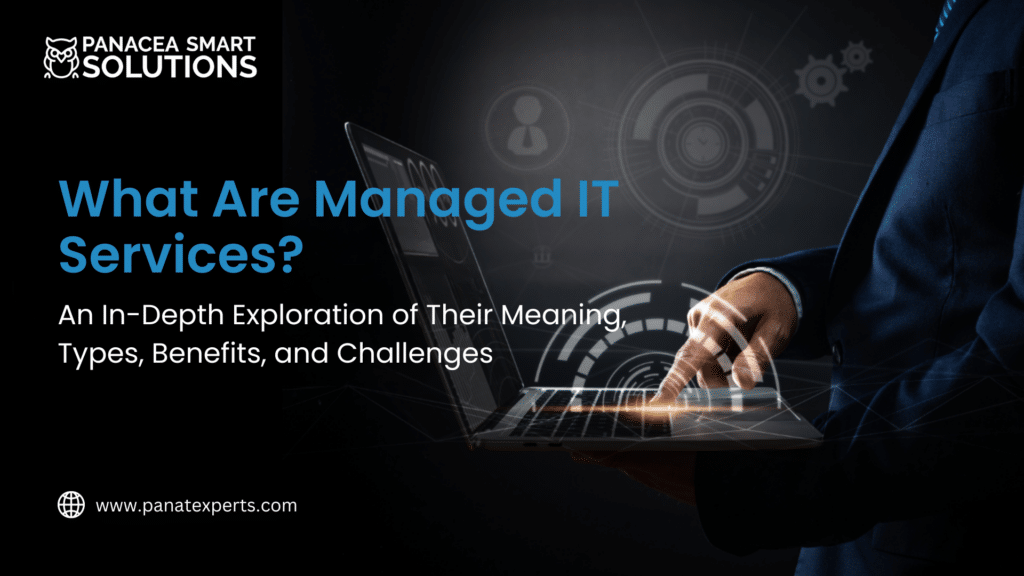In the rapidly evolving landscape of business technology, Managed IT Services have become a cornerstone for companies striving for operational excellence. This detailed blog post will delve deeply into Managed IT Services, dissecting their various components, benefits, challenges, and their application across different business sectors, all while maintaining a focus that is accessible to business decision-makers.
Comprehensive Understanding of Managed IT Services
Managed IT Services are an amalgamation of various IT tasks and responsibilities that are outsourced to specialized providers. This concept encompasses a broad spectrum of IT-related activities, ranging from basic network maintenance to intricate cybersecurity strategies. The primary goal is to streamline and enhance business operations through expert management of technological resources, providing businesses the freedom to concentrate on strategic growth initiatives rather than day-to-day IT management.
Detailed Examination of Types of Managed IT Services
1. Remote Monitoring and Management (RMM):
- In-Depth Details: RMM is the backbone of Managed IT Services, offering continuous surveillance and maintenance of a company’s IT infrastructure. It involves real-time monitoring of servers, networks, and computer systems, ensuring they are functioning optimally, and swiftly addressing any anomalies or disruptions.
- Business Impact: RMM’s proactive stance minimizes IT-related disruptions, ensuring that business operations remain fluid and uninterrupted, thereby enhancing overall organizational efficiency.
2. Cybersecurity Services:
- Components Explained: Cybersecurity services encompass a suite of strategies and tools designed to protect businesses from digital threats. This includes the deployment and management of advanced firewalls, regular updates and management of antivirus software, implementation of intrusion detection systems, and comprehensive cybersecurity training for staff.
- Business Relevance Elaborated: In an era where cyber threats are increasingly sophisticated, these services are pivotal in protecting sensitive business data, preserving customer trust, and ensuring compliance with various data protection regulations.
3. Cloud Services:
- Extensive Scope: Managed cloud services entail managing and optimizing cloud-based resources for businesses. This includes overseeing cloud storage, managing cloud-hosted applications, and ensuring the efficient operation of cloud infrastructure.
- Advantages for Businesses Detailed: Cloud services offer scalability, cost-efficiency, and enhanced flexibility, enabling businesses to adapt their IT resources to meet current needs without substantial capital investments.
4. Support and Helpdesk:
- Function Explored: This segment provides ongoing support for all IT-related queries and technical issues faced by employees. It covers a broad range of services, from basic troubleshooting to resolving complex technical challenges.
- Impact on Business Explained: A robust support and helpdesk service significantly boosts employee productivity and satisfaction by ensuring quick resolution of IT issues and maintaining the necessary tools for effective performance.
5. Data Backup and Recovery:
- Critical Importance: These services focus on the regular backup of essential business data and the establishment of effective recovery processes.
- Business Significance Expounded: In instances of data loss due to hardware failure, human error, or cyberattacks, a solid backup and recovery plan is vital for the swift restoration of operations and minimizing business interruption.
Application in Various Business Sectors
Healthcare Sector: Managed IT Services in healthcare are crucial for maintaining patient confidentiality, adhering to healthcare regulations like HIPAA, and managing the IT aspects of advanced medical technologies and electronic health records.
Finance and Banking: In the financial sector, the emphasis is on protecting financial transactions from cyber threats, securing sensitive financial data, and ensuring compliance with industry-specific regulations like SOX or GLBA.
Retail Industry: In retail, Managed IT Services support enhanced point-of-sale systems, effective inventory database management, and secure e-commerce platforms, ensuring a seamless customer shopping experience.
Manufacturing: These services in manufacturing focus on integrating IT with industrial automation, optimizing production processes, managing supply chain logistics, and ensuring uninterrupted operation of manufacturing systems.
Benefits of Managed IT Services Expounded
1. Cost Efficiency Detailed: By converting capital expenditures into predictable operational costs, businesses can effectively budget for their IT needs. This model reduces the overall costs associated with maintaining a comprehensive in-house IT team.
2. Access to Expertise: Businesses benefit from access to a diverse pool of IT experts and specialists, offering insights and capabilities that might be beyond the scope of an internal team.
3. Scalability and Flexibility: These services provide the agility to scale IT operations up or down based on current business demands, offering a tailored approach to IT management.
4. Enhanced Business Focus: Offloading IT responsibilities allows companies to redirect their focus towards core business activities, fostering innovation and strategic growth.
Challenges and Key Considerations
1. Security and Privacy Concerns: The delegation of IT functions involves handing over sensitive data to third parties, necessitating stringent security measures and trust in the provider’s capabilities.
2. Regulatory Compliance: Ensuring that the service provider adheres to industry-specific regulations is critical, especially in sectors with stringent data protection laws.
3. Reliance on External Providers: Dependency on external services for critical IT functions can pose risks, making it essential to have contingency plans and clear SLAs.
4. Provider Selection: Identifying a provider that aligns with a company’s unique requirements and culture is crucial for a successful partnership.
5. Effective Communication: Establishing and maintaining clear, consistent communication channels is vital to ensure that the services provided align with the business’s objectives and expectations are met.
Concluding Thoughts
Managed IT Services have become a vital component of contemporary business strategy, offering a blend of expert knowledge, cost-efficiency, and technological advancement. The selection of an appropriate service provider and the alignment of services with business objectives are key to fully leveraging these services. With the right partnership, Managed IT Services can transform IT challenges into catalysts for growth and innovation.





